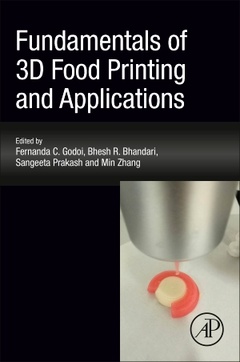Description
Fundamentals of 3D Food Printing and Applications
Coordinators: Godoi Fernanda C., Bhandari Bhesh, Prakash Sangeeta, Zhang Min
Language: English
Subject for Fundamentals of 3D Food Printing and Applications:
Keywords
3D food printer; 3D food printing technology; 3D food printing; 3D modelling; 3D printing (3DP)Additive manufacturing; 3D printing; 3D structure; 3D-printed food; Additive manufacturing; Agglomeration; Binder jetting; Business model innovation; Casein; Cereal-based products; Chocolate; Confectionary; Connected device; Customised foods; Digital platforms; Dysphagia; Environment friendly; Extrusion-based 3DFP; FDA; Firmware; Food consumption; Food design; Food printing; Food production; Food value chains; G-code; Gel forming; Gelation; GMO; Healthy; Homemade food; Ink; Inkjet printing; Innovative food formulation; Insect-enriched products; Internet of things; Labelling; Lactose; Material formulation; Mechanical properties; Melting extrusion; Microstructure; Milk fat; Personalized nutrition; Polysaccharides; Postprocessing technologies; Postprocessing; Powder; Print and eat; Print movements; Printability; Printing precision; Process parameters; Prosumption; Reproduction fidelity; Safety; Self-supporting mechanism; Shape fidelity; Slicing software; Sustainability; Sustainable; Thermoreversibility; Use-cases; Whey protein
406 p. · 15x22.8 cm · Paperback
Description
/li>Contents
/li>Readership
/li>Biography
/li>Comment
/li>
Fundamentals of 3D Food Printing and Applications provides an update on this emerging technology that can not only create complex edible shapes, but also enable the alteration of food texture and nutritional content required by specific diets. This book discusses 3D food printing technologies and their working mechanisms within a broad spectrum of application areas, including, but not limited to, the development of soft foods and confectionary designs. It provides a unique and contemporary guide to help correlate supply materials (edible inks) and the technologies (e.g., extrusion and laser based) used during the construction of computer-aided 3D shapes.
Users will find a great reference that will help food engineers and research leaders in food science understand the characteristics of 3D food printing technologies and edible inks.
2. 3D Food Printing Technologies and Factors Affecting Printing Precision
3. Critical Variables for Quality in Manufacturing 3D Printed Food
4. Cereal-based and Insect-enriched Printable Food: From Formulation to Post Processing Treatments: Status and Perspectives
5. 3D Printed Food from Fruit and Vegetables
6. 3D Printing Chocolate: Properties of Formulations for Extrusion, Sintering, Binding and Ink jetting
7. Potential Applications of Dairy Products, Ingredients and Formulations in 3D Printing
8. Material, Process and Business Development for 3D Chocolate Printing
9. Creation of Food Structures through Binder Jetting
10. 3D Food Printing Technology at Home, Domestic Application
11. Prosumer Driven 3D Food Printing: Role of Digital Platforms in Future 3d Food Printing Systems
12. Safety and Labeling of 3D-Printed Food
13. Future Outlook of 3D Food Printing
undergraduate and graduate students as well as faculty/researcher in food science/engineering, industry (product development), government researchers and also the public interested in emerging technologies.
Professor Bhesh Bhandari has been associated with the University of Queensland for the last 30 years. His research and teaching areas include food materials science, processing, physical and engineering properties of foods. Prof Bhandari has published three co-edited books and more than 500 book chapters and research papers. His publications have been cited more than 36000 times (Google scholar) and is recognised as one of the leading researchers globally in glass transition and encapsulation technologies in food science discipline. He has patented two significant technologies, a continuous microgel particle formation device for encapsulation of food and pharmaceuticals and a technology to produce ethylene powder by applying materials science approach. He has currently several projects on 3D food printing.
Dr Prakash is an academic at UQ with over a decade of experience focused on research related to food processing and the oral and gastrointestinal dynamics of complex food systems. Coordinate and teach – Food Sensory and Structures and Functional Food. Her experimental approaches span from the use of processing devices (3D food prin
- Details existing 3D food printing techniques, with an in-depth discussion on the mechanisms of formation of self-supporting layers
- Includes the effects of flow behaviour and viscoelastic properties of printing materials
- Presents strategies to enhance printability, such as the incorporation of hydrocolloids and lubricant enhancers
- 3D printing features of a range of food materials, including cereal based, insect enriched, fruits and vegetables, chocolate and dairy ingredients
- Business development for chocolate printing and the prospects of 3D food printing at home for domestic applications
- Prosumer-driven 3D food printing
- Safety and labelling of 3D printed food
These books may interest you

Polymers for Food Applications 210.99 €

Polymers for Food Applications 126.59 €


